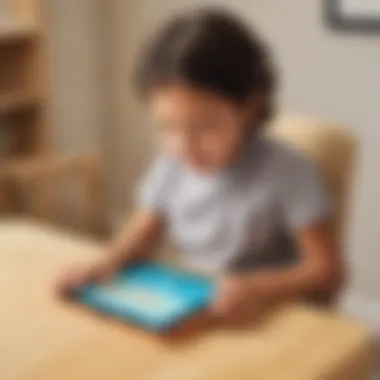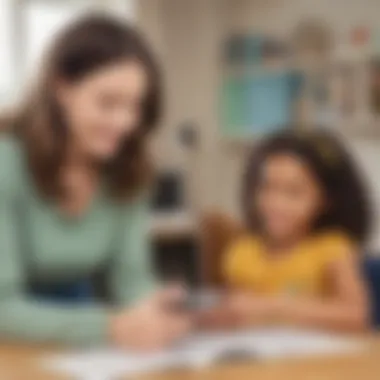Exploring Spelling Word Apps for Android: A Comprehensive Guide


Intro
In the digital age, learning has become more dynamic than ever, especially for children. Android spelling word applications play a vital role in this transformation. These apps are designed to make spelling and literacy development engaging and effective for children aged three to twelve. Understanding how these tools work is essential for parents, educators, and caregivers seeking to enhance a child's learning experience. By exploring the core functionalities and educational benefits these applications offer, we can guide informed decisions in selecting suitable resources.
Interactive Learning Games
Interactive learning games represent a fundamental component of effective educational applications. These games transform mundane spelling drills into engaging activities that motivate children to learn while playing.
Popular Games
Some noteworthy spelling apps include:
- Spell it Right
- Word Wizard for Kids
- Endless Alphabet
- Spelling Bee
These apps often use colorful graphics, attractive characters, and challenging levels to keep kids interested.
Description of top educational games
Spell it Right offers an extensive database of words appropriate for different age groups. It adapts to the learner's level, ensuring a personalized experience.
Word Wizard for Kids combines phonics with spelling, providing children with tools to sound out words. This method reinforces their understanding of pronunciation and spelling.
Endless Alphabet introduces children to a variety of words through interactive animations and sound effects. It emphasizes vocabulary development alongside spelling skills, providing a comprehensive learning experience.
Benefits of playing educational games for kids' cognitive development
Engaging in these games has proven benefits for cognitive growth.
- Enhances memory retention by reinforcing spelling through repetition.
- Develops problem-solving skills as children navigate game challenges.
- Encourages critical thinking by prompting kids to think about word usage.
Game Reviews
In-depth reviews of selected educational games can be incredibly useful. Spell it Right received high praise for its user-friendliness and adaptability. Many users commend its clean interface and straightforward navigation, making it easy for young learners.
Conversely, Endless Alphabet, while visually appealing, may not offer enough depth in spelling exercises. Users suggest it work better when paired with a complementary app that focuses more on spelling practice.
Comparison of gameplay and learning outcomes
When comparing gameplay and learning outcomes, it is evident that games like Word Wizard for Kids provide a more balanced approach between fun and educational content. Users report significant progress in spelling and phonics after regular use.
Educational Topics
A well-rounded educational experience often includes varied subjects beyond spelling. Various articles cover topics like math, science, and language arts, reinforcing the importance of interdisciplinary learning for holistic development.
- Math: Apps that integrate spelling with math terms help children grasp concepts effectively.
- Science: Learning scientific vocabulary through spelling reinforces children's understanding of subjects and broadens their knowledge.
Children benefit from seeing connections between different areas of study, thereby developing a more comprehensive understanding.
Tips and Tricks
Practical tips can significantly enhance children's learning journey. Here are a few strategies to make learning fun and engaging:
- Set daily goals for spelling practice to create a routine.
- Incorporate games that allow for friendly competition among peers, making learning enjoyable.
- Encourage children to create their own words lists and use them during activities.
These strategies not only facilitate better retention but also boost a child's confidence in their abilities.
Creative DIY Projects
Engaging in creative DIY projects promotes hands-on learning, boosting cognitive and motor skills.
Step-by-Step Guides
Provide detailed instructions for engaging projects:
- Homemade Flashcards: Create durable flashcards for common spelling words.
- Letter Hunt: Organize a letter hunt around the house where children find items starting with specific letters.
- Materials needed: Cardstock, markers, and a laminator.
These activities foster creativity and enhance learning through practical application.
Craft Ideas
A collection of craft ideas using simple household items is a fantastic way to encourage artistic expression.


- Create a spelling wall by decorating words on cardboard.
- Use recycled materials to form letters and spell words physically.
These activities highlight the importance of creativity in a child's development while reinforcing spelling skills in a fun environment.
"Integrating spelling and creativity enriches the learning experience, making it more enjoyable and beneficial for children."
Understanding the Importance of Spelling
Spelling is a crucial component of literacy, forming the foundation for effective communication and comprehension. In this digital age, where technology plays a significant role in education, understanding the importance of spelling can enhance learning experiences for children. This guide will examine how spelling affects literacy skills, communication abilities, and the overall educational development of children.
Foundational Literacy Skills
Spelling contributes significantly to foundational literacy skills. Mastering the art of spelling enables children to decode words, which is vital for reading. A solid grasp of spelling rules and patterns helps learners understand how words are constructed. Moreover, spelling accuracy aids in vocabulary building, allowing children to recognize new words more easily. When children spell well, their reading fluency improves, leading to better comprehension and retention of information. Knowing how to spell encourages confidence in writing, as students are less likely to hesitate when they need to express their thoughts in written form.
Impact on Communication
Effective communication relies heavily on spelling. Children who are proficient in spelling can convey their thoughts clearly and coherently. Poor spelling can lead to misunderstandings or misinterpretations, potentially diminishing the speaker's credibility. For instance, in a school environment, children who submit assignments marred by frequent spelling errors may create a negative impression on their teachers. Furthermore, clear spelling is essential in digital communication, where brevity often accompanies challenges in conveying context. As children move toward adulthood, strong spelling skills will serve them well in both academic and professional settings, enhancing their ability to articulate ideas persuasively.
"Children with strong spelling skills demonstrate a higher level of proficiency in literacy overall, impacting their communication positively throughout their lives."
Understanding spelling's role in literacy and communication underscores the need for effective educational tools, including spelling apps, to support and promote these skills in young learners.
The Role of Technology in Education
In today's educational landscape, technology plays a vital role in enhancing learning outcomes. For many children, it offers interactive and engaging ways to absorb knowledge. In the context of spelling word apps, technology serves as a powerful tool for literacy development. By integrating multimedia elements such as audio, visuals, and games, these apps capture the attention of young learners.
Moreover, technology can bridge gaps in traditional education. It allows children access to resources that may not be available in their standard classroom settings. For parents and educators, this presents an opportunity to customize learning experiences based on individual needs. Personalization is essential in helping children grasp concepts at their own pace.
Technology's role extends beyond mere access to information. It encourages collaboration among students. Many apps allow users to connect and compete or cooperate in spelling activities. This social aspect can reinforce learning while simultaneously nurturing important skills like teamwork and communication.
Advancements in Educational Tools
Recent advancements in educational tools have transformed how children learn spelling. Smart algorithms now adapt lessons based on a child's unique progress. These systems analyze performance data to tailor exercises that challenge users without causing frustration. As a result, children remain engaged, which is crucial for effective learning. This dynamic approach also maintains their interest by ensuring lessons are neither too easy nor too hard.
Furthermore, modern spelling apps often incorporate elements from various learning theories. For example, some use the principles of gamification to make learning enjoyable. Games integrated within these tools promote engagement, helping instill a love for learning. Students do not just memorize words; they enjoy the process, which increases retention.
In addition to adaptation, educational tools are becoming more intuitive and user-friendly. A well-designed interface can enhance a child's experience, allowing them to navigate the app with ease. This ease of use is especially important for younger audiences who might struggle with complex layouts. Simple navigation ensures children spend more time learning rather than figuring out how to use an application.
Benefits of Mobile Learning
Mobile learning, particularly through spelling apps, offers numerous benefits. At the forefront is accessibility. The ability to learn on-the-go makes it easier for children to practice spelling wherever they are. Whether at home, during a commute, or in a waiting room, the opportunities for learning are endless.
This flexibility also encourages consistent practice. Frequent engagement, even in short bursts, can lead to significant improvement over time. A five or ten-minute session can reinforce skills, especially if integrated into a daily routine.
Additionally, mobile learning can promote autonomy in children. Many apps encourage self-directed learning, allowing kids to explore content at their own pace. This empowerment helps them build confidence in their abilities. When children feel in control of their learning, they tend to be more motivated.
"The integration of technology in education fosters an environment where learning can thrive, making literacy development more interactive and engaging."
However, there are concerns. While mobile learning has many advantages, it is essential to balance screen time with traditional educational methods. Engaging with print media, social interaction, and hands-on learning should not be overshadowed by technology. Incorporating mobile learning thoughtfully within a broader curriculum is key.
Overview of Spelling Word Apps
Understanding spelling word apps is crucial in today's educational landscape. These applications bridge the gap between traditional learning and modern technology. Parents and educators increasingly rely on these tools to boost children's spelling and literacy skills. By using these apps, children can engage with language in an interactive way, making learning both enjoyable and effective.
What is a Spelling Word App?
A spelling word app is a digital tool designed to assist users in learning and practicing spelling. These apps typically provide a range of activities that can include flashcards, quizzes, and games. They aim primarily at young learners, often focusing on children aged three to twelve. The interactivity of these apps can facilitate different learning styles, allowing visual and auditory learners to thrive.
Children can select words to study from various categories. Users often have the option to practice spelling through auditory prompts, visual aids, or by typing the words themselves. This flexibility is essential as it caters to the diverse ways in which children absorb information.
Moreover, many spelling word apps have included features that enable parental oversight. This aspect assists parents in tracking progress. They can see which words their child is mastering or struggling with, allowing for personalized guidance in education.
Key Features to Look For
When evaluating spelling word apps, several features can significantly influence their educational value:
- User-Friendly Interface: A simple, intuitive design is vital for young users. The children should navigate the app with ease. A cluttered interface can detract from learning.
- Variety of Activities: Look for apps that include different types of exercises. Mixing quizzes, games, and flashcards fosters greater engagement. Each approach reinforces learning in distinct ways.
- Customizable Word Lists: The ability to create tailored word lists can help meet individual learning needs. This feature is beneficial for educators and parents aiming to focus on specific spelling challenges.
- Progress Tracking: Monitoring improvement is a key aspect of effective learning. Apps that provide reports on progress enable both parents and educators to assess the effectiveness of the tool.
- Engagement Elements: Some apps incorporate gamification to enhance user experience. Rewards for milestones can motivate continued use and effort, making learning less of a chore.
By selecting apps with these features, parents and educators can maximize the benefits of technology in education.
Popular Spelling Word Apps on Android
In today's digital landscape, spelling word apps for Android play a pivotal role in enhancing literacy among children. With young learners increasingly exposed to technology, these tools can significantly impact spelling skills development. The general accessibility of Android devices means that various educational resources are available to families and educators alike. By integrating spelling apps into learning routines, users can benefit from personalized learning experiences that engage children and cater to their unique needs.
These apps often feature interactive games, quizzes, and assessments that make learning entertaining. Parents and educators can monitor progress through analytics and feedback, allowing for tailored educational approaches. Moreover, the adaptability of mobile technology promotes learning at any time and location, enhancing resourcefulness in education.


App One: Description and Features
One notable spelling app available on Android is SpellTower. This app combines word puzzles with spelling practice, making it an enjoyable way for children to learn. SpellTower uses a grid of letters from which players can create words. The more words they spell correctly, the higher their score climbs. This game format encourages critical thinking and vocabulary expansion. The app provides different levels of difficulty, which means it can suit varying age groups and skill levels.
Additionally, SpellTower offers a clean and intuitive interface, making it user-friendly. The engaging design works with the gameplay to maintain children’s interest. The app allows for offline play, which adds convenience for parents and kids alike.
App Two: Description and Features
Another app worth mentioning is Word Wizard. This application targets children who are beginning to learn spelling through phonetic sounds. Word Wizard has a unique feature known as the "talking movable alphabet," allowing children to spell words by dragging letters onto a board. This phonics-based approach fosters connection between sounds and letters, aiding retention.
The app includes over 1,000 sight words and various educational activities, such as spelling tests. Parents can access progress reports to see how their child is doing. This feature assists in identifying areas that may require improvement. Overall, Word Wizard is designed for both usability and efficiency in teaching children.
App Three: Description and Features
Spelling Bee is yet another popular choice among spelling word apps. It revolves around the classic spelling bee competition format, making it familiar and engaging for children. Users take part in spelling challenges against the timer, putting their skill to the test. The app includes different levels tailored for beginners to advanced spellers, ensuring sustained challenge and growth.
Moreover, Spelling Bee offers a variety of word lists, which can be customized for different educational standards. It allows teachers to create specific lists based on their curriculum. The social aspect of competing against friends further motivates children to improve their spelling ability in a fun and interactive way.
Assessing Educational Effectiveness
Evaluating the educational effectiveness of spelling word apps is crucial in understanding their impact on children's learning. Effective assessment methods can help determine how well these apps enhance spelling skills and literacy. This section examines the mechanisms that gauge progress and outcomes, as well as the role of feedback provided by the apps.
Measuring Progress and Outcomes
To measure progress and outcomes in spelling proficiency, apps often implement various tracking features. These tools record a child’s interactions and performance, providing valuable insights for parents and educators.
Some of the common metrics include:
- Accuracy rates: Calculating how many words a child spells correctly helps identify improvement over time.
- Speed of recall: Assessing how quickly a child can spell a word is another indicator of mastery.
- Challenge levels: Many apps adjust the difficulty based on a child's performance, which tracks their growth in real-time.
Apps like Spelling Master and ABC Spelling utilize these metrics to provide detailed reports. These reports track specific words that require more focus and offer personalized practice sessions. Such personalization enhances the learning experience and allows tailored educational approaches that suit individual needs.
Feedback Mechanisms Within Apps
Feedback is a vital component in the learning process. Spelling word apps of today include various feedback mechanisms to inform children about their spelling abilities. This immediate feedback allows for quick adjustments and learning from mistakes. Most apps provide distinct types of feedback, including:
- Correct/incorrect indicators: Simple alerts let children know instantly if their answers are right.
- Hints and explanations: Some apps, like SpellWizard, offer context or tips for difficult words, fostering deeper understanding.
- Progress badges: Gamified feedback can increase motivation by rewarding achievements, encouraging continual learning.
"The use of timely feedback not only reinforces correct spelling but also builds a child's confidence and encourages continued effort."
User Experience and Engagement
User experience (UX) and engagement are critical components in the efficacy of spelling word apps for Android. These elements play a major role in how children interact with the application, influencing not only their motivation to practice but also the overall learning outcomes. A well-designed user experience creates an intuitive interface that promotes seamless navigation, helping users to focus on improving their spelling skills rather than figuring out how to use the app.
From an educational standpoint, engagement encompasses various factors, including the enjoyment level a child derives from the experience, their willingness to return to the app, and their ability to stay focused during practice sessions. Ultimately, high engagement typically leads to improved learning retention and mastery of spelling.
Interface and Usability
The interface of a spelling app refers to the visual layout and interactive elements that a user encounters. A user-friendly design is essential for keeping children interested and facilitating their learning journey. For instance, an app with overly complex menus and navigation can lead to frustration and disengagement.
Here are some important aspects of interface and usability to consider:
- Clarity of design: Icons and buttons should be clearly labeled and easily understood. This helps children navigate the app without confusion.
- Responsive interaction: Quick response to user input can enhance the feeling of control and encourage continued interaction.
- Accessibility options: Features such as text-to-speech and adjustable font sizes can cater to different learning styles and needs.
- Feedback mechanisms: Immediate positive feedback for correct answers, along with constructive tips for mistakes, can reinforce learning effectively.
Gamification Elements
Gamification in spelling apps involves the incorporation of game-like features to make learning more engaging and enjoyable. This method utilizes various elements to motivate users, sustain interest, and facilitate learning. Here are key aspects of gamification worth noting:
- Progress tracking: Allowing users to view their progress encourages achievement and accountability. This can be shown through levels, badges, or scores.
- Challenges and rewards: Introducing levels of difficulty or challenges that yield rewards can stimulate a competitive spirit and encourage children to push their limits. Reward systems can include virtual gifts or unlocking new content, which keeps the experience fresh.
- Interactive challenges: Incorporating quizzes or spelling games where children compete against themselves or others can enhance engagement. Collaborative tasks encourage social interaction, pivotal for child development.
In summary, a well-designed user experience, characterized by an intuitive interface and effective gamification strategies, is vital in ensuring that spelling word apps not only attract but also hold the attention of young learners. With the right approach, these elements can significantly enhance the educational value of the apps, making spelling practice a productive and enjoyable activity.
Parental and Educational Insights
The integration of spelling word apps into children’s learning processes invites a discussion on parental and educational insights. Understanding this dynamic helps in navigating the challenges and benefits of these digital learning tools. Parents and educators have unique experiences that can inform their choices regarding which apps to use, how to implement them effectively, and the expected outcomes of their usage.
Parent Reviews and Recommendations
Parental feedback is crucial when evaluating spelling apps. Many parents share their thoughts via online forums or review platforms. These insights often highlight practical experiences that go beyond the app's marketing claims. Parents appreciate when an app tracks progress, offers personalized exercises, or encourages consistency through reminders. For instance, apps like Spelling Bee provide tailored challenges that adapt to a child's evolving skill set, receiving positive reviews for their user-friendly interface and progress reports.
"The real-time feedback my child receives has motivated him to improve. It’s a powerful tool beyond just learning words!"
— A Parent’s Review
Moreover, reviews often focus on usability. Parents prefer apps that are not only educational but also engaging. They look for features such as interactive graphics and sound effects, which keep children interested. Such functionality is critical when involving younger children, particularly those aged three to six, who are just beginning their literacy journey. Apps that incorporate story elements or gamified learning experiences tend to be well-received.
Educators’ Perspectives on App Utilization


Educators view spelling word apps as adjuncts to traditional teaching methods. In classrooms, these tools can supplement direct instruction, particularly for differentiated learning. Teachers report that apps foster engagement, especially among students who may struggle with traditional literacy tasks. The immediate feedback offered through apps allows students to understand their mistakes right away, reinforcing learning.
Educators also emphasize the importance of content quality. An app that aligns with curriculum standards is more likely to gain acceptance in educational settings. Teachers often recommend apps that include comprehensive vocabulary lists, phonetic exercises, and varying difficulty levels that cater to a range of learning capabilities. This adaptability encourages all students to progress at their own pace.
Additionally, educators advocate for balance. While apps can enhance spelling skills, they shouldn't replace interactive activities, such as reading together or writing exercises. Thus, combining technology with traditional literacy practices can create a robust learning environment.
Integrating Apps into Learning Environments
Integrating spelling word apps into learning environments is crucial for enhancing literacy development among children. These applications not only serve as educational tools but also offer dynamic resources that engage young learners. The integration of technology, specifically spelling apps, creates a dual advantage by providing a platform that aligns with modern educational standards and caters to diverse learning styles.
Incorporating these apps into both home and classroom settings can promote independent learning. Children can practice spelling in an interactive format, allowing them to take ownership of their learning experience. Moreover, such integration may foster better retention of spelling skills through regular practice and positive reinforcement. Without a doubt, understanding how to properly integrate these tools can influence a child's engagement and progress.
Strategies for Home Use
When using spelling apps at home, establishing a routine can enhance effectiveness. Here are several strategies:
- Set Specific Times for Practice: Designate certain times during the week for spelling practice. Consistency helps children build a habit, making learning a regular part of their daily life.
- Combine with Traditional Methods: Use spelling apps alongside traditional learning methods. For example, after practicing with an app, have children write the words down or use them in sentences. This reinforces their learning through different modalities.
- Create a Reward System: Encourage motivation by establishing a rewards system. Recognizing milestones achieved on the app can foster a positive attitude towards learning.
- Encourage Parental Involvement: Parents should engage alongside their children. This presence not only makes the process enjoyable, but also provides opportunities for discussions about words and their meanings.
Using Apps in the Classroom
In a classroom setting, the integration of spelling apps can transform lesson dynamics. Teachers can adopt these suggested practices:
- Incorporate into Lesson Plans: Use spelling apps as part of the daily lesson. Integrating them with existing curriculum can enhance traditional methods and bring new life to lessons.
- Facilitate Group Activities: Encourage collaborative learning by having students use apps in small groups. Group activities can lead to discussions about spelling rules and strategies, enhancing peer learning.
- Use for Assessments: Teachers can use spelling word apps as informal assessment tools. This could include using game-like assessments to evaluate students' understanding in a non-threatening manner.
- Gather Feedback: Collect feedback from students about the apps used. Understanding students’ perspectives can help teachers refine their approach and make necessary adjustments for future lessons.
Potential Limitations and Challenges
While spelling word apps can offer numerous benefits, it is essential to recognize their limitations and challenges. Understanding these aspects is fundamental for parents, educators, and caregivers who wish to maximize the educational value of these digital tools. This section focuses on two prominent concerns: screen time and quality assurance of application content.
Screen Time Concerns
One of the main issues related to the use of spelling word apps is the concern about screen time. Many children are already engaging with screens, such as TVs, tablets, and smartphones, for various activities. The rise of digital learning tools can potentially add to this screen time, raising questions about the balance between effective learning and excessive use.
Parents often worry about the implications of prolonged exposure to screens. Research indicates that excessive screen time can lead to inattentiveness, sleep disturbances, and even behavioral concerns. Therefore, it is crucial to establish healthy boundaries regarding the duration and context in which children use spelling apps. Setting limits helps in mitigating any negative effects associated with excessive screen exposure.
Recommendations for Managing Screen Time:
- Limit the duration: Set a reasonable daily limit for app usage.
- Combine activities: Encourage a mix of screen-based and non-screen activities, like outdoor play and hands-on learning.
- Monitor content: Ensure that the apps chosen are educational and promote engagement through interactive features.
The goal is not to eliminate screen time entirely but to manage it in a way that supports balanced development.
Quality Assurance of App Content
Another critical challenge involves the quality assurance of content within spelling word apps. The educational landscape is riddled with numerous apps claiming to enhance literacy skills. However, not all applications are created equal. Some might not align with educational standards or may contain inaccuracies in the material they present.
Parents and educators must critically evaluate the content quality. Poor-quality resources can lead to misunderstanding and reinforce incorrect spelling habits. It becomes crucial to check for instructional design, relevance of vocabulary, and age-appropriateness.
Tips for Ensuring Quality:
- Research app providers: Look for reviews from other users and insights from educational websites like Britannica or Wikipedia.
- Trial usage: Some apps offer free trials. Take advantage of these to gauge the app's effectiveness before committing.
- Update frequency: Quality programming often includes regular updates to stay current with educational standards.
Taking time to research and verify app content assures that children benefit from reliable resources that truly enhance their spelling skills.
"An educated choice in apps can greatly influence a child's ability to learn and apply new spelling skills effectively."
Hence, addressing these limitations and challenges is vital to ensure that the benefits of spelling word apps are fully realized while minimizing possible drawbacks.
Future Trends in Spelling Education
In the digital age, spelling education is rapidly evolving. Understanding future trends in this domain is crucial for educators, parents, and anyone involved in child education. Technology’s influence on learning is gaining momentum, shaping how spelling is taught. The shift from traditional methods to technology-based approaches encourages more interactive and engaging ways for students to learn spelling. This section examines particular trends that are expected to influence the future of spelling education significantly.
Emerging Technologies in Education
Technological advancements are driving new methods of teaching and learning. Apps designed for spelling instruction are utilizing emerging technologies such as artificial intelligence, augmented reality, and machine learning. These technologies adapt learning experiences to each child's needs. For instance, AI can analyze student performance in real time, adjusting difficulty levels accordingly. This allows for a personalized learning journey that caters to the unique strengths and weaknesses of each learner.
The integration of augmented reality also presents an exciting opportunity. By combining visual and auditory stimuli, educational Apps enhance interaction and retention. Children may, for example, see a word in 3D while hearing its pronunciation, making the learning experience more memorable. This multisensory approach reinforces memory and understanding.
Furthermore, the incorporation of voice recognition technology can assist young learners in improving their spelling through verbal input. Feedback from such systems helps to correct errors, guiding students toward accurate spelling.
The Evolving Landscape of Learning Apps
As competition in the app marketplace grows, we see an increasing number of spelling apps. Many of them are designed for young learners and prioritize user-friendly interfaces. These apps often incorporate dynamic features that keep children engaged.
Some key aspects of their evolution include:
- Focus on User Engagement: Modern spelling apps are incorporating game-like elements to motivate students. This gamification creates a more engaging environment, fostering a positive attitude towards learning.
- Social Learning Features: Many new apps offer social sharing capabilities. Students can share their progress and compete with peers, promoting a sense of community in learning.
- Content Updates: To stay relevant, many developers are frequently updating their apps with new content. This ensures that users can continuously find fresh materials.
- Data-Driven Insights: Today’s apps provide analytical dashboards for parents and educators. These insights allow for monitoring progress and identifying areas needing improvement, making it easier to adjust instruction methods.
To summarize, future trends in spelling education signify a shift towards more interactive, personalized, and data-oriented approaches. Keeping abreast of these trends ensures that educators and parents can effectively support children's literacy development in meaningful ways.
"Emerging technologies transform how students interact with spelling education, making learning not only easier but also enjoyable."
By analyzing trends, stakeholders can better grasp how to use available resources effectively. As these trends continue to unfold, the goal remains clear: to enhance the literacy skills of children aged three to twelve through innovative approaches.















